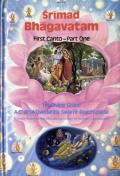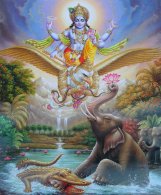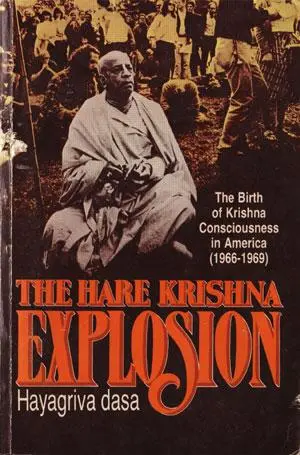Srila Prabhupada Cuts a Record
(from ‘Broadcasting Krsna’s Glories’ by Satsvarupa dasa Gosvami)
“At the studio, everyone accepted the devotees as a regular music group. One of the rock musicians asked them what the name of their group was, and Hayagriva laughed and replied, “The Hare Krsna Chanters.” Of course most of the devotees weren’t actually musicians, and yet the instruments they brought with them — a tamboura, a large harmonium (loaned by Allen Ginsberg), and rhythm instruments — were ones they had played during kirtanas for months.
So as they entered the studio they felt confident that they could produce their own sound. They just followed their Swami. He knew how to play, and they knew how to follow him. They weren’t just another music group. It was music, but it was also chanting, meditation, worship.
Prabhupada sat on a mat in the center of the studio, while the engineers arranged the microphones and assigned each devotee a place to sit according to his instrument. When the engineers were satisfied, they cued the devotees, and Swamiji began chanting and playing his drum.
The first sound was the tamboura, with its plucked, reverberating twang. An instant later Swamiji began beating the drum and singing, Vande ‘ham sri-guroh . . . .
Then the whole ensemble put out to sea-the tamboura, the harmonium, the clackers, the cymbals, Rupanuga’s bells, Swamiji’s solo singing-pushing off from their moorings, out into a fair-weather sea of chanting. . . . lalita-sri-visakhanvitams ca . . . .
Swamiji’s voice in the studio was very sweet. His boys were feeling love, not just making a record. There was a feeling of success and union, a crowning evening to all their months together.
. . . . sri-krsna-caitanya, prabhu-nityananda . . . .
After a few minutes of singing prayers alone, Swamiji paused briefly while the instruments continued pulsing, and then began the mantra: Hare Krsna, Hare Krsna, Krsna Krsna, Hare Hare. It was pure Bhaktivedanta Swami — expert, just like his cooking in the kitchen, like his lectures. The engineers liked what they heard — it would be a good take if nothing went wrong. The instruments were all right, the drum, the singing. The harmony was rough. But this was a special record — a happening. The Hare Krsna Chanters were doing their thing, and they were doing it all right. Alan Kallman was excited. Here was an authentic sound. Maybe it would sell.
After a few rounds of the mantra, the devotees began to feel relaxed, as though they were back in the temple, and they were able to forget about making mistakes on the record. They just chanted, and the beat steadied into a slightly faster pace. The word hare would come sometimes with a little shout in it, but there were no emotional theatrics in the chorus, just the straight response to the Swami’s melody. Ten minutes went by. The chanting went faster, louder and faster-Swamiji doing more fancy things on the drum, until suddenly . . . everything stopped, with the droning note of the harmonium lingering.
Alan came out of the studio: “It was great, Swami. Great. Would you like to just go right ahead and read the address now? Or are you too tired?” With polite concern, pale, befreckled Alan Kallman peered through his thick glasses at the Swami. Swamiji appeared tired, but he replied, “No, I am not tired.” Then the devotees sat back in the studio to watch and listen as Prabhupada read his prepared statement.
“As explained on the cover of the record album…” The sympathetic devotees thought that Swamiji, despite his accent, sounded perfectly clear, reading from his script like an elocutionist. “. . . this transcendental vibration by chanting of Hare Krsna, Hare Krsna, Krsna Krsna, Hare Hare, Hare Rama, Hare Rama, Rama Rama, Hare Hare is the sublime method for reviving our Krsna consciousness.” The language was philosophic, and the kind of people who usually walked out of the temple as soon as the kirtana ended, before the Swami could even speak a word, would also not appreciate this speech on their record album.
“As living spiritual souls,” Swamiji preached, “we are all originally Krsna conscious entities. But due to our association with matter from time immemorial, our consciousness is now polluted by material atmosphere.” The devotees listened submissively to the words of their spiritual master, while at the same time trying to comprehend the effect this would have on the audience. Certainly some people would turn it off at the very mention of a spiritual nature. Swamiji continued reading, explaining that the chanting would deliver one from the sensual, mental, and intellectual planes and bring one to the spiritual realm.
“We have seen it practically,” he continued. “Even a child can take part in the chanting, or even a dog can take part in it. . . . The chanting should be heard, however, from the lips of a pure devotee of the Lord.”
And he continued reading on to the end. . .
“No other means, therefore, of spiritual realization is as effective in this age as chanting the maha-mantra: Hare Krsna, Hare Krsna, Krsna Krsna, Hare Hare/ Hare Rama, Hare Rama, Rama Rama, Hare Hare.”
Alan again came rushing out of the studio. It was fine, he said. He explained that they had recorded a little echo into the speech, to make it special for the listener.
“Now,” he pushed back his glasses with his finger. “We’ve got about ten minutes left on the side with the speech. Would you like to chant again? Or is it too late, Swamiji?” Prabhupada smiled. No, it was not too late. He would chant the prayers to his spiritual master.
While his disciples lounged around the studio, watching their spiritual master and the technical activity of the engineers behind the glass, Prabhupada began singing. Again the harmonium’s drone began, then the tamboura and drum, but with a much smaller rhythm group than before. He sang through, without any retakes, and then ended the song (and the evening) with a fortissimo drumming as the hand-pumped organ notes faded.
Again, Alan came out and thanked the Swami for being so patient and such a good studio musician. Prabhupada was still sitting.
“Now we are tired,” he admitted.
Suddenly, over the studio sound system came a playback of the Hare Krsna chanting, complete with echo. When Prabhupada heard the successful recording of his chanting, he became happy and stood and began dancing, swaying back and forth, dipping slightly from the waist, his arms upraised in the style of Lord Caitanya, dancing in ecstasy. The scheduled performance was over, but now Swamiji was making the best performance of the evening from his spontaneous feelings. As he danced, his half-asleep disciples became startled and also rose to their feet and joined him, dancing in the same style. And in the recording booth behind the glass, the engineers also raised their hands and began dancing and chanting.
“Now you have made your best record,” Swamiji told Mr. Kallman as he left the studio for the freezing Manhattan evening. Swamiji got into the front seat of the Volkswagen bus while “The Hare Krsna Chanters” climbed into the back with their instruments, and Rupanuga drove them back home, back to the Lower East Side.”
(from ‘Broadcasting Krsna’s Glories’ by Satsvarupa dasa Gosvami)
















Mar 01, 2023 @ 21:29:02
Please, how can we hear it?
Mar 02, 2023 @ 07:32:29
Hare Krishna To hear go to http://www.prabhupadaconnect.com/Prabhupada-Chants-Hare-Krishna-Happening-Album.mp3